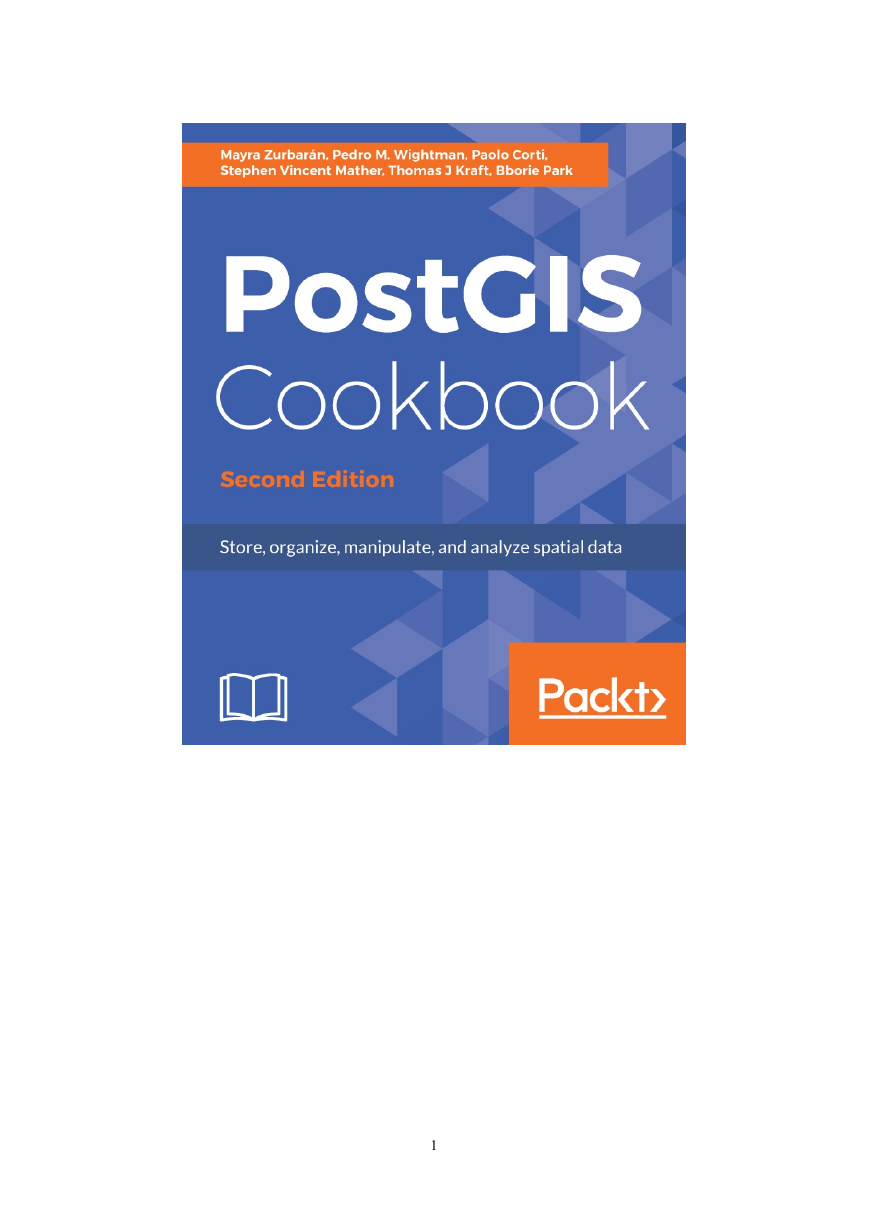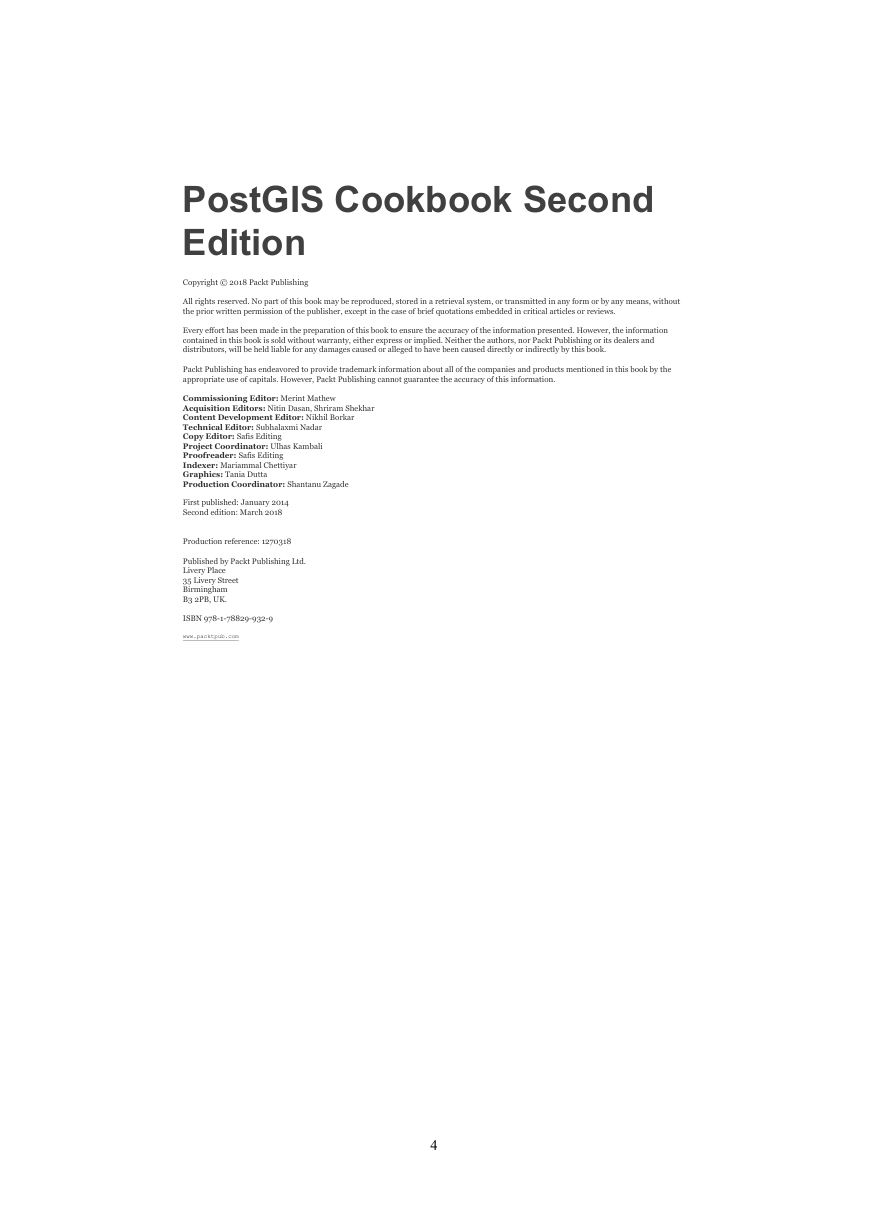PostGIS Cookbook, Second Edition
Title Page
Copyright and Credits
PostGIS Cookbook Second Edition
Packt Upsell
Why subscribe?
PacktPub.com
Contributors
About the authors
Packt is searching for authors like you
Preface
Who this book is for
What this book covers
To get the most out of this book
Download the example code files
Download the color images
Conventions used
Sections
Getting ready
How to do it…
How it works…
There's more…
See also
Get in touch
Reviews
Moving Data In and Out of PostGIS
Introduction
Importing nonspatial tabular data (CSV) using PostGIS functions
Getting ready
How to do it...
How it works...
Importing nonspatial tabular data (CSV) using GDAL
Getting ready
How to do it...
How it works...
Importing shapefiles with shp2pgsql
How to do it...
How it works...
There's more...
Importing and exporting data with the ogr2ogr GDAL command
How to do it...
How it works...
See also
Handling batch importing and exporting of datasets
Getting ready
How to do it...
How it works...
Exporting data to a shapefile with the pgsql2shp PostGIS command
How to do it...
How it works...
Importing OpenStreetMap data with the osm2pgsql command
Getting ready
How to do it...
How it works...
Importing raster data with the raster2pgsql PostGIS command
Getting ready
How to do it...
How it works...
Importing multiple rasters at a time
Getting ready
How to do it...
How it works...
Exporting rasters with the gdal_translate and gdalwarp GDAL commands
Getting ready
How to do it...
How it works...
See also
Structures That Work
Introduction
Using geospatial views
Getting ready
How to do it...
How it works...
There's more...
See also
Using triggers to populate the geometry column
Getting ready
How to do it...
There's more...
Extending further...
See also
Structuring spatial data with table inheritance
Getting ready
How to do it...
How it works...
See also
Extending inheritance – table partitioning
Getting ready
How to do it...
How it works...
See also
Normalizing imports
Getting ready
How to do it...
How it works...
There's more...
Normalizing internal overlays
Getting ready
How to do it...
How it works...
There's more...
Using polygon overlays for proportional census estimates
Getting ready
How to do it...
How it works...
Working with Vector Data – The Basics
Introduction
Working with GPS data
Getting ready
How to do it...
How it works...
Fixing invalid geometries
Getting ready
How to do it...
How it works...
GIS analysis with spatial joins
Getting ready
How to do it...
How it works...
Simplifying geometries
How to do it...
How it works...
Measuring distances
Getting ready
How to do it...
How it works...
Merging polygons using a common attribute
Getting ready
How to do it...
How it works...
Computing intersections
Getting ready
How to do it...
How it works...
Clipping geometries to deploy data
Getting ready
How to do it...
How it works...
Simplifying geometries with PostGIS topology
Getting ready
How to do it...
How it works...
Working with Vector Data – Advanced Recipes
Introduction
Improving proximity filtering with KNN
Getting ready
How to do it...
How it works...
See also
Improving proximity filtering with KNN – advanced
Getting ready
How to do it...
How it works...
See also
Rotating geometries
Getting ready
How to do it...
How it works...
See also
Improving ST_Polygonize
Getting ready
How to do it...
See also
Translating, scaling, and rotating geometries – advanced
Getting ready
How to do it...
How it works...
See also
Detailed building footprints from LiDAR
Getting ready
How to do it...
How it works...
Creating a fixed number of clusters from a set of points
Getting ready
How to do it...
Calculating Voronoi diagrams
Getting ready
How to do it...
Working with Raster Data
Introduction
Getting and loading rasters
Getting ready
How to do it...
How it works...
Working with basic raster information and analysis
Getting ready
How to do it...
How it works...
Performing simple map-algebra operations
Getting ready
How to do it...
How it works...
Combining geometries with rasters for analysis
Getting ready
How to do it...
How it works...
Converting between rasters and geometries
Getting ready
How to do it...
How it works...
Processing and loading rasters with GDAL VRT
Getting ready
How to do it...
How it works...
Warping and resampling rasters
Getting ready
How to do it...
How it works...
Performing advanced map-algebra operations
Getting ready
How to do it...
How it works...
Executing DEM operations
Getting ready
How to do it...
How it works...
Sharing and visualizing rasters through SQL
Getting ready
How to do it...
How it works...
Working with pgRouting
Introduction
Startup – Dijkstra routing
Getting ready
How to do it...
Loading data from OpenStreetMap and finding the shortest path using A*
Getting ready
How to do it...
How it works...
Calculating the driving distance/service area
Getting ready
How to do it...
See also
Calculating the driving distance with demographics
Getting ready
How to do it...
Extracting the centerlines of polygons
Getting ready
How to do it...
There's more...
Into the Nth Dimension
Introduction
Importing LiDAR data
Getting ready
How to do it...
See also
Performing 3D queries on a LiDAR point cloud
How to do it...
Constructing and serving buildings 2.5D
Getting ready
How to do it...
Using ST_Extrude to extrude building footprints
How to do it...
Creating arbitrary 3D objects for PostGIS
Getting ready
How to do it...
Exporting models as X3D for the web
Getting ready
How to do it...
There's more...
Reconstructing Unmanned Aerial Vehicle (UAV) image footprints with PostGIS 3D
Getting started
How to do it...
UAV photogrammetry in PostGIS – point cloud
Getting ready
How to do it...
UAV photogrammetry in PostGIS – DSM creation
Getting ready
How to do it...
PostGIS Programming
Introduction
Writing PostGIS vector data with Psycopg
Getting ready
How to do it...
How it works...
Writing PostGIS vector data with OGR Python bindings
Getting ready
How to do it...
How it works...
Writing PostGIS functions with PL/Python
Getting ready
How to do it...
How it works...
Geocoding and reverse geocoding using the GeoNames datasets
Getting ready
How to do it...
How it works...
Geocoding using the OSM datasets with trigrams
Getting ready
How to do it...
How it works...
Geocoding with geopy and PL/Python
Getting ready
How to do it...
How it works...
Importing NetCDF datasets with Python and GDAL
Getting ready
How to do it...
How it works...
PostGIS and the Web
Introduction
Creating WMS and WFS services with MapServer
Getting ready
How to do it...
How it works...
See also
Creating WMS and WFS services with GeoServer
Getting ready
How to do it...
How it works...
See also
Creating a WMS Time service with MapServer
Getting ready
How to do it...
How it works...
Consuming WMS services with OpenLayers
Getting ready
How to do it...
How it works..
Consuming WMS services with Leaflet
How to do it...
How it works...
Consuming WFS-T services with OpenLayers
Getting ready
How to do it...
How it works...
Developing web applications with GeoDjango – part 1
Getting ready
How to do it...
How it works...
Developing web applications with GeoDjango – part 2
Getting ready
How to do it...
How it works...
Developing a web GPX viewer with Mapbox
How to do it...
How it works...
Maintenance, Optimization, and Performance Tuning
Introduction
Organizing the database
Getting ready
How to do it...
How it works...
Setting up the correct data privilege mechanism
Getting ready
How to do it...
How it works...
Backing up the database
Getting ready
How to do it...
How it works...
Using indexes
Getting ready
How to do it...
How it works...
Clustering for efficiency
Getting ready
How to do it...
How it works...
Optimizing SQL queries
Getting ready
How to do it...
How it works...
Migrating a PostGIS database to a different server
Getting ready
How to do it...
How it works...
Replicating a PostGIS database with streaming replication
Getting ready
How to do it...
How it works...
Geospatial sharding
Getting ready
How to do it...
How it works...
Paralellizing in PosgtreSQL
Getting ready
How to do it...
How it works...
Using Desktop Clients
Introduction
Adding PostGIS layers – QGIS
Getting ready
How to do it...
How it works...
Using the Database Manager plugin – QGIS
Getting ready
How to do it...
How it works...
Adding PostGIS layers – OpenJUMP GIS
Getting ready
How to do it...
How it works...
Running database queries – OpenJUMP GIS
Getting ready
How to do it...
How it works...
Adding PostGIS layers – gvSIG
Getting ready
How to do it...
How it works...
Adding PostGIS layers – uDig
How to do it...
How it works...
Introduction to Location Privacy Protection Mechanisms
Introduction
Definition of Location Privacy Protection Mechanisms – LPPMs
Classifying LPPMs
Adding noise to protect location data
Getting ready
How to do it...
How it works...
Creating redundancy in geographical query results
Getting ready
How to do it...
How it works...
References
Other Books You May Enjoy
Leave a review - let other readers know what you think
















 2023年江西萍乡中考道德与法治真题及答案.doc
2023年江西萍乡中考道德与法治真题及答案.doc 2012年重庆南川中考生物真题及答案.doc
2012年重庆南川中考生物真题及答案.doc 2013年江西师范大学地理学综合及文艺理论基础考研真题.doc
2013年江西师范大学地理学综合及文艺理论基础考研真题.doc 2020年四川甘孜小升初语文真题及答案I卷.doc
2020年四川甘孜小升初语文真题及答案I卷.doc 2020年注册岩土工程师专业基础考试真题及答案.doc
2020年注册岩土工程师专业基础考试真题及答案.doc 2023-2024学年福建省厦门市九年级上学期数学月考试题及答案.doc
2023-2024学年福建省厦门市九年级上学期数学月考试题及答案.doc 2021-2022学年辽宁省沈阳市大东区九年级上学期语文期末试题及答案.doc
2021-2022学年辽宁省沈阳市大东区九年级上学期语文期末试题及答案.doc 2022-2023学年北京东城区初三第一学期物理期末试卷及答案.doc
2022-2023学年北京东城区初三第一学期物理期末试卷及答案.doc 2018上半年江西教师资格初中地理学科知识与教学能力真题及答案.doc
2018上半年江西教师资格初中地理学科知识与教学能力真题及答案.doc 2012年河北国家公务员申论考试真题及答案-省级.doc
2012年河北国家公务员申论考试真题及答案-省级.doc 2020-2021学年江苏省扬州市江都区邵樊片九年级上学期数学第一次质量检测试题及答案.doc
2020-2021学年江苏省扬州市江都区邵樊片九年级上学期数学第一次质量检测试题及答案.doc 2022下半年黑龙江教师资格证中学综合素质真题及答案.doc
2022下半年黑龙江教师资格证中学综合素质真题及答案.doc